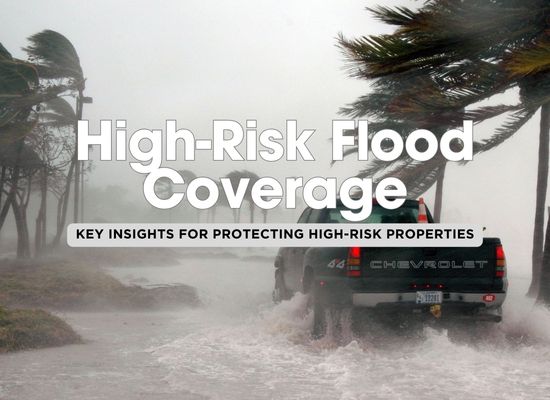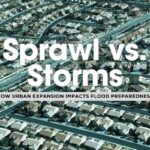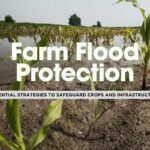Living in a flood-prone area can be daunting, especially if you’re in a high-risk flood zone. 🌊 For property owners in these areas, having the right flood insurance is not just important—it’s essential. With the increasing frequency of extreme weather events, flooding has become a major risk, even in areas where it wasn’t previously a concern. In this guide, we’ll walk you through everything you need to know about flood insurance for high-risk properties, ensuring you’re protected when disaster strikes.
1. Why High-Risk Properties Need Flood Insurance
Flooding can happen at any time, but high-risk properties are especially vulnerable due to their location in flood-prone zones. 🚨 These properties are typically in areas where the likelihood of flooding is greater, such as near rivers, coastlines, or areas with poor drainage systems.
Why It Matters:
- Financial Protection: Without flood insurance, the cost of repairing flood damage could be devastating. Homeowners without insurance may have to pay out of pocket for repairs, which can run into the tens of thousands of dollars.
- Home Value: Flood-prone properties without insurance are often harder to sell, as potential buyers may hesitate to invest in a property without adequate coverage.
- Peace of Mind: Knowing you’re covered gives you peace of mind, allowing you to weather a storm (literally and figuratively) without worrying about what comes next.
What You Can Do:
- Check if your property is in a high-risk zone by referring to FEMA’s flood map. If you’re in a flood zone, securing flood insurance is non-negotiable.
2. Understanding Flood Zones
Flood zones are areas categorized based on their risk of flooding. They are determined by FEMA and play a significant role in determining flood insurance requirements and premiums. High-risk areas are typically designated as Zone A or Zone V.
Flood Zone Categories:
- Zone A: This is a high-risk zone, where properties have a greater chance of being flooded due to storm surges, rivers, or coastal waters.
- Zone V: These areas are also at high risk, typically along coastal areas that are vulnerable to storm surge and coastal flooding.
- Zone X (Moderate to Low Risk): While these areas may not face a high risk of flooding, they can still experience significant water damage from heavy rains or storms.
Why It Matters:
- Mandatory Insurance: If you live in a high-risk zone (A or V), flood insurance may be mandatory, especially if you have a mortgage.
- Cost of Premiums: The cost of insurance can vary significantly depending on the flood zone. Properties in higher-risk zones tend to have higher premiums due to the increased likelihood of a flood event.
What You Can Do:
- Review FEMA’s flood zone map to confirm the risk level of your property. This will help you understand your insurance requirements and premiums.
3. What’s Covered by Flood Insurance?
Flood insurance covers damage to your property and belongings caused by flooding. However, it’s important to understand exactly what’s included and what’s excluded in your policy to ensure you’re adequately protected.
What’s Typically Covered:
- Building Property: Includes structural damage to your home or building—such as the foundation, walls, windows, and roof—caused by flooding.
- Personal Property: Covers belongings like furniture, clothing, electronics, and other items damaged by floodwaters.
- Additional Living Expenses: If your home becomes uninhabitable due to flooding, flood insurance can cover additional living costs, such as temporary housing.
What’s Not Covered:
- Flood Prevention: If your home is damaged due to a lack of floodproofing or maintenance, these costs are generally not covered.
- Landscaping and Outdoor Structures: While some items like outdoor furniture may be covered, landscaping, driveways, and pools are generally excluded from coverage.
What You Can Do:
- Read your policy carefully to understand coverage limits, exclusions, and any optional add-ons. If needed, you can customize your flood insurance to better protect specific items or areas.
4. The Role of FEMA in Flood Insurance
The Federal Emergency Management Agency (FEMA) plays a major role in flood insurance for high-risk properties. FEMA administers the National Flood Insurance Program (NFIP), which provides affordable flood insurance to property owners in participating communities.
Why It Matters:
- Mandatory Flood Insurance: If you live in a high-risk flood zone and have a mortgage from a federally regulated or insured lender, you may be required to purchase flood insurance through the NFIP.
- Affordable Coverage: The NFIP is often more affordable than private flood insurance options, making it a key resource for homeowners in flood-prone areas.
- Rebuilding Support: FEMA provides financial assistance for rebuilding after a flood, but only if you have flood insurance through the NFIP.
What You Can Do:
- Visit FEMA’s website to learn more about the NFIP and to see if your community participates in the program. If you’re required to have flood insurance, it’s important to purchase it through an NFIP-participating insurer.
5. Flood Insurance Premiums: What Affects the Cost?
Flood insurance premiums can vary significantly based on several factors, including the location of your property and its susceptibility to flooding. Understanding what factors affect your premiums can help you manage costs.
Factors That Affect Premiums:
- Flood Zone: Properties in high-risk flood zones (A and V) generally face higher premiums due to the greater risk of flooding.
- Elevation: The elevation of your property above sea level can significantly impact your premium. Properties with a lower elevation or those below the base flood elevation are more expensive to insure.
- Building Characteristics: The age, type, and construction of your property also influence premiums. For example, homes built with flood-resistant materials may qualify for lower premiums.
- Coverage Limits: The more coverage you need, the higher your premium. You can choose to increase your policy limits for buildings and personal property, but that comes at a cost.
What You Can Do:
- Consider a flood elevation certificate to potentially lower your premium by verifying your property’s elevation.
- Shop around for flood insurance providers to compare rates, as premiums can differ depending on the insurer.
6. How to File a Flood Insurance Claim
In the unfortunate event that your property floods, understanding how to file a claim is essential to getting the help you need. Filing a claim can sometimes be complex, but following the correct steps ensures a smoother process.
Steps to File a Claim:
- Contact Your Insurance Provider: Notify your insurer as soon as possible to start the claims process.
- Document the Damage: Take photos and videos of all flood damage to your property and belongings. This documentation will help support your claim.
- Fill Out the Claims Forms: Your insurer will provide you with forms to complete, which may ask for detailed information about the damage.
- Work with an Adjuster: An insurance adjuster may visit your property to assess the damage. Be sure to provide them with your documentation and any supporting information.
- Review Your Settlement: Once the claim is processed, review the settlement offer from your insurer to ensure it aligns with your policy coverage.
What You Can Do:
- Keep a record of all communication with your insurer and adjuster.
- Be proactive about submitting documents and following up on your claim to avoid delays.
7. The Difference Between Flood Insurance and Homeowners Insurance
Many homeowners are surprised to learn that standard homeowners insurance doesn’t cover flood damage. This is where flood insurance becomes essential for properties in high-risk areas.
Why It Matters:
- Homeowners Insurance: Typically covers damages from fire, theft, or storms, but not flooding.
- Flood Insurance: Specifically designed to cover water damage caused by flooding. It’s a separate policy that works alongside your homeowners insurance to fill in this gap.
What You Can Do:
- Review Your Current Insurance: Make sure your homeowners insurance policy doesn’t include coverage exclusions for flood damage. If it doesn’t, purchase separate flood insurance through the NFIP or a private insurer.
8. What to Do if You’re Denied Coverage
If your flood insurance application is denied, it can feel discouraging, but there are steps you can take to find the coverage you need.
Why It Happens:
- High-Risk Areas: Some insurance companies may be hesitant to offer coverage in extremely high-risk flood zones.
- Claims History: If your property has previously been flooded and had extensive damage, you may face difficulty getting coverage.
What You Can Do:
- Appeal the Decision: You can appeal the denial or look for a different provider.
- Seek Government Assistance: If you’re unable to find private insurance, FEMA’s NFIP is a crucial resource for obtaining coverage, even in high-risk areas.
9. Optional Flood Insurance Add-Ons
While standard flood insurance covers many aspects of flood damage, there are some optional add-ons or endorsements you can purchase for extra protection.
Common Add-Ons:
- Basement Coverage: Standard flood insurance policies often don’t cover damage to basements, but you can purchase additional coverage.
- Flood-Related Mold and Mildew Coverage: Mold growth after flooding can cause serious damage, and additional coverage can help mitigate these costs.
- Increased Coverage Limits: If you own high-value items, you might consider increasing your personal property coverage to fully protect your belongings.
What You Can Do:
- Evaluate Your Property: Consider purchasing add-ons based on your property’s unique features, like a basement or valuable personal belongings that need extra protection.
10. The Importance of Reviewing Your Flood Insurance Regularly
Your flood risk may change over time due to factors like local development, climate change, or improvements made to flood defenses. Regularly reviewing your flood insurance policy ensures that it’s always up-to-date with your needs.
Why It Matters:
- Changing Risks: Flood zones can shift, and new flood mapping may indicate an increased or decreased risk of flooding.
- Updated Coverage: If you’ve made renovations or additions to your property, it’s important to update your coverage to reflect these changes.
What You Can Do:
- Annual Reviews: Check your policy every year, especially if you’ve made any home improvements or if there are changes in your area’s flood risk.
- Stay Informed: Keep track of local flood maps and FEMA updates to understand if your risk has changed.
Flood insurance is an essential part of protecting your high-risk property. 🏠🌊 With the right coverage, you can have peace of mind knowing that your home and belongings are protected against the unexpected. Whether you’re in a high-risk flood zone or facing changing weather patterns, understanding your flood insurance options is key to safeguarding your property and minimizing potential financial losses.
By regularly reviewing your policy, understanding the types of coverage, and advocating for your needs, you’ll be well-prepared to handle any flood-related risks. Don’t wait until it’s too late—take action today to protect your home and everything you value. 🌟



